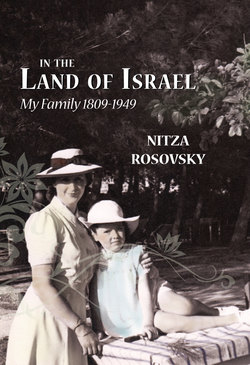In the Land of Israel: My Family 1809-1949

Реклама. ООО «ЛитРес», ИНН: 7719571260.
Оглавление
Nitza Rosovsky. In the Land of Israel: My Family 1809-1949
CONTENTS
INTRODUCTION
PART ONE. TIBERIAS
IN SEARCH OF FAMILY HISTORY
INTERVIEWS
THE “FAMILY BIBLE”
TIBERIAS CEMETERY
GOING UP TO THE HOLY LAND
HASIDUT AND ALIYA
THE 1777 ALIYA
WEAVING THE THREADS. THE MONTEFIORE CENSUSES
HINKE BASHA AND AVRAHAM PINHAS
THE EARTHQUAKE
THE WORLD OF MENAHEM MENDEL EPSTEIN
THE JEWISH COMMUNITY OF TIBERIAS
“SQUALOR AND POVERTY”
MENAHEM MENDEL AND KOLEL REISIN
THE FAMILY ASHKENAZI. ARRIVAL FROM TELENESHTI
MORDECHAI MOTTEL ASHKENAZI
FROM BEIRUT TO JERUSALEM. SARAH BRANDEIS-ELSTEIN
PART TWO. JERUSALEM
THE BERMAN FAMILY’S BEGINNINGS. THE BERMANS’ ARRIVAL IN PALESTINE
NINETEENTH-CENTURY JERUSALEM
THE BUSINESS AND THE FAMILY
BETWEEN THE OLD AND THE NEW
THE GREAT WAR. THE GREAT WAR BEGINS
THE SURRENDER OF THE HOLY CITY
IN THE AFTERMATH OF THE WAR. THE EARLY DAYS OF THE BRITISH MANDATE
BACK TO NORMAL
THE FAMILY FIRM
SARAH AND ELIYAHU IN THE 1920S
GRANDPA’S PASSPORT
THE RIOTS IN 1929
THE EARLY THIRTIES. THE BAKERY FROM 1930 TO 1933
LOVE AND MARRIAGE
PART THREE. WITHIN MEMORY
HOME AND HEARTH
THE HOUSE
DRAMATIS PERSONAE
THE BROWNS
MORE BERMAN WEDDINGS
THE ARAB REVOLT, 1936-1939
WEEKDAYS AND HOLIDAYS. THE DAILY ROUTINE
RUNNING THE HOUSEHOLD
CLOTHES
CLEANLINESS
SATURDAYS
HOLIDAYS
THE EARLY YEARS. ELEMENTARY EDUCATION
CHILDHOOD AILMENTS
FRIENDS
PETS, PESTS, AND VERMIN
WORLD WAR II. THE WAR IN PALESTINE
BIRTHS AND WEDDINGS IN THE BERMAN FAMILY
LILY KOLCZYCKI
AT THE HEBREW GYMNASIUM
FAMILY AFFAIRS. BACK TO MY PARENTS
FORBIDDEN LOVE
THE ROAD TO INDEPENDENCE. THE DISPLACED JEWS OF EUROPE
REACTION IN THE YISHUV
IN THE BERMAN FAMILY
JERUSALEM BESIEGED
THE END OF A CHAPTER. MOTHER
HAMISH DOUGAN
EPILOGUE
ACKNOWLEDGMENTS
ENDNOTES. TIBERIAS
JERUSALEM
WITHIN MEMORY
Отрывок из книги
SOMEWHERE UP IN HEAVEN my great-grandmother, Esther Ashkenazi Brandeis, must be chuckling. During my childhood, whenever Jerusalem was in winter’s icy grip, I used to crawl under her quilt at night and beg for a story. Baba Esther knew many tales, tales set against the mountains of Safed and the Sea of Galilee where she grew up, enchanting tales about shepherds and fishermen, shoemakers and washerwomen. But whenever she strayed into reality and reminisced about her own life, my attention wandered. Facts, after all, were so boring. Half a century later, as I was interviewing one relative after another, rushing from archive to library to cemetery in an effort to piece together my family’s history, I could almost hear Esther saying: “Ah, Nitzaleh, if you had only listened!”
When I began my search for roots I also realized how little I knew about Jews in Europe, where my ancestors came from, even though I was a graduate of the Hebrew Gymnasium in Jerusalem, a well-known secular high school, where my classmates and I spent many hours a week studying the annals of the Jewish people. But it was almost as if history stopped in AD 70 when the Romans destroyed Jerusalem, bringing Jewish sovereignty to an end, and resumed in 1881, when the first Zionists left Eastern Europe for Eretz Israel, the Land of Israel. Eighteen centuries of Jewish life in the Diaspora hardly seemed to matter.
.....
ELTE LEAH—OR LEAH—the daughter of Avraham and Hinke, was already married in 1839 when the first census was taken. Her husband was Menahem Mendel Epstein who was born in Minsk, Belarus, in 1821 and arrived in Palestine in 1836. Jews had lived in Minsk since the sixteenth century and the city’s Polish rulers granted them the right to own land and to engage in crafts and commerce. Even after 1793, when the city came under Russian rule, Jews continued to do well there, both materially and spiritually. When Menahem left, the Jewish community numbered about twelve thousand, one of the largest in Russia.
In Tiberias, Menahem joined the Russian kolel. By then, Hasidut itself had changed since splits began to occur among the Baal Shem’s followers in Europe after his death in 1760. At first the leadership passed on to his disciple, Dov Baer, the Maggid of Mezeritch, but by the third generation, as the movement continued to spread, individual zadikim, the leaders of the Hasidim, set up their own courts where each interpreted the Baal Shem’s teachings in his own way. Decentralization thus resulted in bitter disputes among various sects and, for both ideological and practical reasons, what happened in Europe affected the Hasidim in Eretz Israel. Near the end of the eighteenth century a major quarrel broke out in the country among the Hasidim over the division of funds collected in Belarus and Volhyn, and the Russian Hasidim broke away and established their own kolel, Kolel Reisin. Avraham of Kalisk, one of the leaders of the 1777 aliya, led the kolel until his death in 1810.
.....